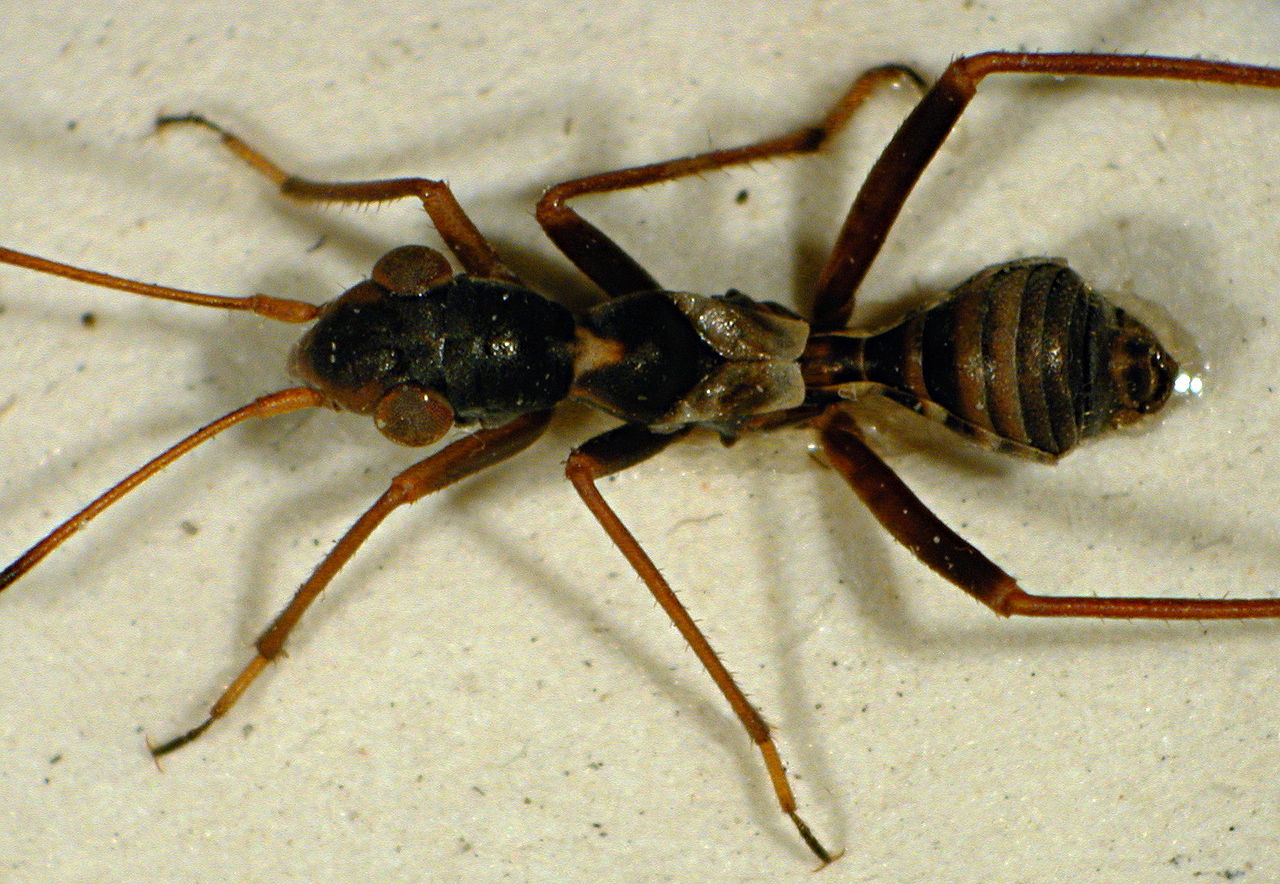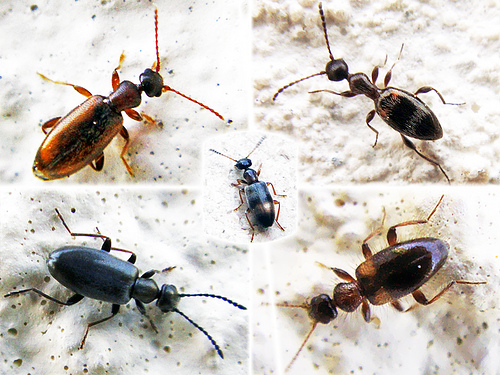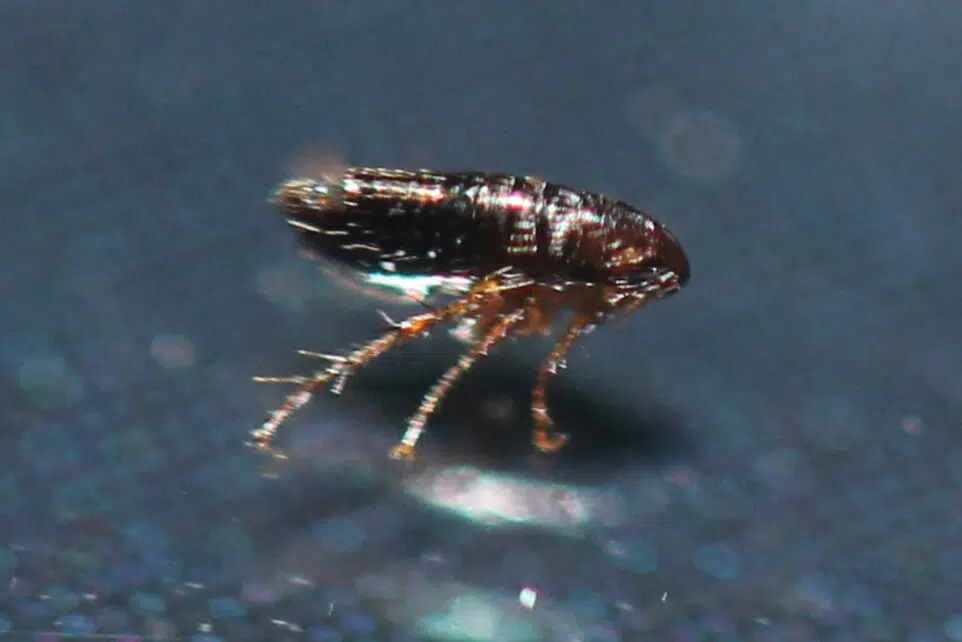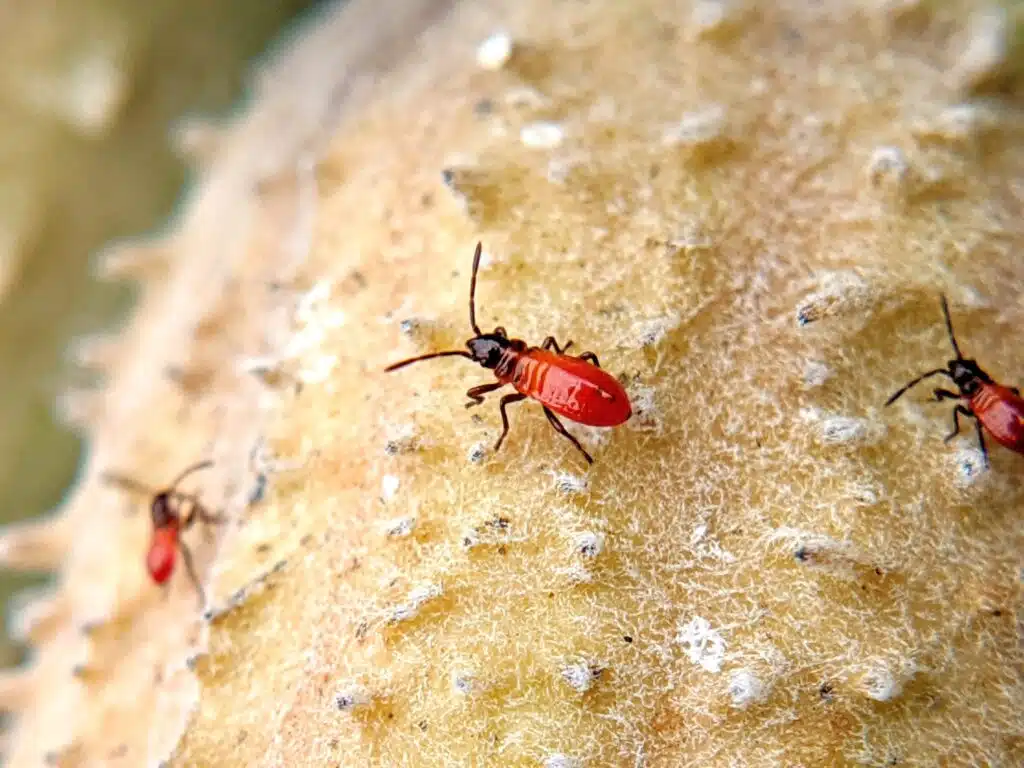Ants are some of the most common house pests. Attracted to food, they make their way indoors in high numbers either in the spring or in the summer.
Eliminating ants involves getting rid of all the foods they are interested in. This is not going to eliminate all bugs that look like ants or which are confused with ants.
Table of Contents
Ant Identification
Ants are some of the most common types of insects found inside the house or in the garden. There are many types of ants that come in different sizes and colors.
- Colors
Black, brown, red, and yellow are just a few of the common colors ants come in. You can find colorful ants inside the house or outside in the garden.

- Size
Ants have varying sizes. In general, they have a size that falls between 1 and 50mm. The exact size of an ant depends on its species as well as on food availability.
Elongated body with a thin waist, ants always have a sculpted body. Chances are a bug is not an ant if it has a thick waist.
- Diet
Fruits, seeds, leaves, carrion, and other insects are among the most common types of foods consumed by ants. A single species might not consume all of these as ant species have certain food preferences.
- Habitat
Ants are found all around the world. From deserts to woodlands, ants are found on all continents in all weather, with the exception of Antarctica.
Bugs That Look Like Ants
The following species are mostly confused for ants by their looks. Diet and habitat preferences might also confuse these species with ants.
1. Termites

Termites live in large colonies in their thousands. They are often found around homes and this makes many people confuse them with ants.
Termites also come in some colors ants come in, such as brown. Termites can have an off-white or cream color, which is not the case with ants.
With a similar size, termites are often confused with ants further.
While small, both termites and ants can be analyzed when it comes to the shape of the body, the easiest way to tell the difference between these insects.
Ants have a sculpted body which isn’t the case with termites which have a thick waist.
While the abdomen of both termites and ants can be wider than the rest of the body, the shape of the waist is what makes ants different.
Even ants with a wide abdomen have a thin waist in relation to the width of the body.
Termites are known to eat plenty of cellulose. This is an organic material found in wood which is what scares most homeowners when it comes to termites.
Ants don’t eat wood even if they can nest in wood. Ants can dig long galleries in the wood but these ants aren’t dominant. Most eat simple foods such as fruits and organic materials.
2. Velvet Ants

Velvet ants are some of the most difficult types of bugs to differentiate from real ants to those who haven’t seen them before.
While this group is named after ants, it actually represents wasps. Some species of wasps mimic other species, which is also the case of Velvet ants which are wasps that mimic ants.
The size of the species is the first indication you’re dealing with Velvet ants. These are a few times larger than the typical ant you see in the garden.
Seen in colors such as orange, red, and brown, velvet ants might first seem to have the same color as real ants but they have a hairy body which gives them away.
These types of wasps do not act as wasps. They do not fly as they crawl to get around, just like ants.
Movements of these bugs make many predators take them as ants and move along.
Velvet ants can also sting. The result of the sting is a very high level of pain so velvet ants should not be handled directly.
The stinger of velvet ants is a few times larger than the stinger of regular ants. Velvet ants have a stinger that can be as long as half the size of the species.
The habitat of velvet ants can also confuse some people. Both regular ants and velvet ants are found on all continents except Antarctica and both can wander indoors looking for food or shelter.
3. Aphids

Aphids are sometimes confused with ants in the garden. Aphids rarely make it indoors, unless they are carried with potted plants or if they look for food themselves.
Ants and aphids live in direct correlation as the species benefit from each other.
Aphids feed on various plants leaving residue known as honeydew behind. This sweet honeydew is consumed by ants that live on the same host plant.
The presence of ants on plants also benefits aphids which aren’t as likely to be eaten by predators afraid of ants.
Aphids are generally green, yellow, or red. These bugs can also be brown or red, somewhat similar to ants.
The shape of aphids should be the first major difference between the species apart from the color. Aphids have an oval shape while ants have a sculpted body with a thin waist.
Ants are highly likely to only eat honeydew while aphids are likely to eat the leaves of plants. Many aphids eat vegetables in the garden.
4. Spiders
Spiders are also one of the most common pests inside the house. They exist even in homes where food is properly stored.
Spiders can make it indoors looking for shelter or for insects. They can build spider webs or simply prey upon insects found indoors.

Some spiders are known to directly mimic ants. This species of spider (Myrmarachne formicaria) has a red to brown color and a body shape that mimic ants. Both the color and the thin abdomen make these spiders look like ants.
The species can be differentiated by most ants by its jumping abilities. However, these spiders prefer to crawl across the ground to look like real ants.
These are among the few spiders that mimic ants found in North America. Myrmarachne is a genus of spiders that mimic ants and their order is mostly found in the tropics except for Myrmarachne formicaria.
You can find these spiders that mimic ants across the United States. Northern states such as Ohio have been among the first places where the mimicking spider has been first reported.
5. Bush Crickets

Bush crickets can sometimes be confused with large ants in the garden. Most bush crickets are green, which means they aren’t easily confused.
However, brown or red-brown bush crickets can get confused with ants.
One of the easiest methods of separating these species is by looking at their size. Bush crickets tend to measure up to 2-3 inches, which makes them a few times larger than ants.
The shape of the body should also indicate visible differences between these species. Bush crickets have an elongated body with a wide mid-section while ants have a thin elongated body with a thinner sculpted mid-section.
Otherwise, the habitat of bush crickets and ants can overlap. Both are visible from April to October even if local differences apply.
Crickets also make their distinct sound which further separates them from ants. You can find most bush crickets on low grasses and in thick vegetation while ants tend to frequently move into open areas as well.
6. True Bugs

True bugs encompass the order of Hemiptera. These are some of the largest bug categories in the world including thrips, aphids, and ladybugs.
Some ladybugs can have a similar size to ants but their shape and color are different. Most ladybugs have a dome-shaped body and not an elongated sculpted body such as ants.
Other true bugs are known for feeding with plants and other insects, similarly to ladybugs. These types of bugs are often pests on crops as they can feed on various fruit and vegetables such as tomatoes.
7. Stick Insects
Stick insects are a type of thin elongated bugs that are highly similar in color, shape, and size to ants.
Most stick insects only live in tropical and sub-tropical areas which means you should not expect to see them in temperate climates.
Stick insects are also known as Walking insects. They have a thin elongated body that mimics sticks so that predators move along.
This mimicry works as the insects have few natural predators.
Since stick insects resemble sticks, they do not have a sculpted body as ants. Stick insects have a flat body with somewhat constant width.
Both stick insects and ants eat leaves and plant stems which might make them look similar at first. However, stick insects do not eat other insects.
8. Thrips

Thrips are a type of true bug often confused with ants.
Similar in size, these tiny bugs also come in a brown color that frequently makes people take them for ants.
Thrips also have an elongated body but there’s a difference in their shape that makes them appear different to ants.
Thrips have a pointed rear abdomen but they have a wide or a wider waist. Ants have a thin sculpted waist.
The food these insects eat should also make them stand out from typical ants.
Thrips used to consume all types of fungi but have since adapted to eating different types of leaves.
Woody galls are often formed on trees thrips live on.
Often living in large groups, thrips can resemble ants that live in colonies from a eusocial perspective. However, ants do not form galls or swell on trees.
9. Mantises
Mantises are a type of long thin insect sometimes confused with ants. These types of insects are seen as some of the most common species that feed on aphids and other insects.
Mantises are carnivores while many ants aren’t.
Brown mantises such as Archimantis latistyla or the Large brown mantis can sometimes be confused with ants.
However, this type of bug feeds almost exclusively on other large bugs.
Mantises of this genus even eat grasshoppers, which isn’t the case with ants.
You know the bug in your garden isn’t an ant when it has its front legs together as if sitting in a praying position. This position inspires the name of mantises.
10. Flies
Not all flies look the same. Drain flies have a brown color and a sleek sculpted body.
These flies have transparent wings.
Similarities might end here as these types of flies are born in the organic buildup in drains, which inspires their name.
Drain flies are some of the most common brown flies you can wrongly identify as well.
However, these types of flies mostly eat decomposing organic matter which should make for clear species separation even if some ants may also eat rotting foods.
11. Beetles

Not all beetles can be taken for ants but those of the Anthicidae genus can.
These beetles are among the most common types of brown beetles that are taken for ants.
They even eat the same foods ants eat. This includes leaves, fungi, and pollen.
With a similar size and red to brown color as some ants, this species tends to have a wider waist and body, unlike many sculpted ants.
Some of these beetles are also known to have few natural predators, just as ants. They absorb toxins from plants which makes them taste bad.
12. Springtails

Springtails are small hexapods that resemble ants. Once seen as insects, these small bugs come in different sizes and species.
Most Springtail species measure between 0.1 and 0.2 inches, which means their sizes make them similar to ants.
Dark brown and often seen with a stripe across the abdomen, Springtails are mostly dark and with their long antennae, may be confused with ants.
Some of the most common springtails in the world can jump. They catapult themselves high into the air, mainly to check out the ground around them.
Like ants, springtails can have a varied diet. Unlike ants, springtails also eat all types of animal material, vegetable materials, bacteria, and even fungi.
They are considered highly beneficial to the ecosystem as they naturally filter out bacteria and fungi.
Springtails may also be beneficial to the world through the nutrients they recycle. These end up in the ground, increasing soil quality.
Apart from their food preferences and location, Springtails can be differentiated from ants by the way they move.
These types of bugs jump high, while ants move slowly, on the ground, on plants, or on walls.
13. Lice

Lice are so small they are sometimes confused with ants. Their reduced size often makes their color undistinguishable.
Most lice are somewhat smaller than most ants. They are about half the size of regular ants in gardens but both can get indoors, with different associated risks.
Lice can be troublesome both to humans and animals. While some ants bite, there are many ant species that don’t.
Most lice need a host, and this means they are considerably more problematic than ants.
Unlike ants, lice may be picked up when in contact with an infested person.
Unlike springtails, lice cannot jump. They crawl slowly through hair and their movements can help differentiate them from ants.
Apart from having a brighter appearance, lice are also considerably slower than ants as they cannot fly or jump.
Lice are also named after the body parts they live on. Head lice are named after their tendency to live in hairs while body and pubic lice live on the body.
Eliminating these 2 species is also completely different.
Extra attention is required to remove lice while ants may even be kept away by sealing entryways to the house or by eliminating all of the foods they are attracted to.
14. Fleas

Fleas are small and brown (when unfed). Knowing for their blood-thirsty bite, fleas are small, growing to a size of up to 0.5 inches.
This reduced size plus the brown or red-brown appearance makes fleas somewhat similar to ants.
A round shape should be the first indication you’re spotting fleas and not ants.
This is a different body shape compared to a standard ant which has a thread-like waist or a sculpted waist, according to more official terminology.
Fleas also jump, high! Most fleas can jump tens of times their own body size, something most species of ants can’t.
Only a few types of ants such as Jack Jumpers (Myrmecia pilosula) are known to jump, unlike most fleas.
Furthermore, fleas need a host as they require blood to survive and reproduce.
Both fleas and ants can live in grassland, woodlands, and other types of rich vegetation areas. However, they enter homes by different means and for different reasons.
Fleas enter homes with pets, animals, or humans while ants can only make their own way indoors in large numbers for food or when they have a nearby nest.
Both died within days without a meal.
Some of the most resilient fleas can survive 1-2 weeks without a host. Ants also live 2 weeks without food.
Fleas can also survive cold winters and they might be some species that may harmlessly make their way indoors even in the wintertime.
Snow fleas are among the species that are highly active in the winter. They are seen moving around on snow as they don’t might the excessively-cold weather.
While they also look like small ants, Snow fleas are a distinct species of fleas that don’t bite. They aren’t typically interested in indoor living either.
15. Aphid Wasps

Aphid wasps grow to a size between 0.07 and 0.19 inches. They are comparable in size and shape to different types of ants.
Dark brown or black, aphid wasps even have wings, being similar to winged ants.
These types of bugs are only found on very specific crops and on different types of plants they consume.
Separating Aphid Wasps from ants may be difficult in appearance alone. Both have a thread-like waist.
You can correctly identify Aphid Wasps based on the plants you see them on.
These insects are found on different flowers, especially those rich in nectar such as caraway.
Clovers are another highly common host plants of the species you know many ants don’t have a particular interest in.
Even more, these types of flying aphids are found on wild mustards, cultivated mustards, and on the parsley in your garden!
Some ants may also eat parsley for its sugar but prefer to eat other types of plant leaves.
By far, the easiest way to differentiate aphids from ants is by looking at their young. Small ants may look like adult miniature ants.
Young Aphid Wasps are tan and wingless. They have a round shape and black legs.
These young bugs congregate on plants. Small clumps of brown bugs on plants such as parsley are an indication adult Aphid Wasps are about to emerge.
16. Wheel Bug Nymphs

Both adult and nymph stage Wheel Bugs are known, as predators. These types of bugs play an important role in the ecosystem.
Some even encourage their presence on crops or in gardens as these types of assassin bugs feed on detrimental species.
While adults aren’t the most ant-resembling species, Wheel Bug Nymphs look almost exactly like ants!
These young Wheel Bugs have a mostly black color in their early days, with a sculpted body, similar to the body of various ants.
As they grow, they are still mostly black, with orange or orange-red abdomens, still somewhat similar to ants.
Unlike some types of ants, these nymphs remain highly aggressive, as are the adults.
Some of the most aggressive nymphs are those that appear in multiple broods per year, such as The Wheel Bug Nymphs of Florida.
As they enter their late instars, these nymphs eventually become yellow or yellow-orange, resembling termites.
Their feeding habits are quickly developed. Wheel Bug Nymphs can eat almost the same types of prey adults eat.
Caterpillars are among the first type of prey they consider.
17. Seed Bug Nymphs

Seed Bugs are present in North America and their nymphs may sometimes be confused with ants.
Like many ant species, these nymphs are mostly found on trees. They feature a similar small size and a thin body with 6 legs.
The thin body of these nymphs isn’t narrower at the waist, which is one of the main differentiating factors between the nymphs and ants.
These nymphs are also brown or black at first, slowly becoming brighter as they go from one instar to another.
Seed Bug Nymphs additionally get a yellow or orange abdomen in their late instars while their legs and bodies remain dark brown or even black.
Seed Bugs are named after their feeding habits which are based on various seeds. But should you worry when spotting these bugs and their nymphs in the garden?
It turns out many types of bugs and their nymphs feed on emerging seeds such as pine cone seeds.
Asa a result, they cannot be considered as dangerous or even supposedly dangerous for trees themselves
These nymphs also end up as prey for small birds and other predators that feed on small bugs and insects.
18. Ant-mimicking Treehopper

Unlike many Seed Bug Nymphs that end up being eaten by predators, Ant-mimicking Treehoppers (Cyphonia clavata) do everything they can to avoid falling prey.
They even go as far as to take on the appearance of an ant so that predators move along.
These types of treehoppers actually look like ants from above!
An ant-shaped upper dorsum and head come in dark brown to black colors to mimic ants when seen from above.
The rest of the body is yellow or green, more specific to typical treehoppers.
However, not only does it take on the colors of ants, but this species of treehopper also has ant-specific body shapes on its upper dorsum.
This ant-shaped dorsum also includes a helmet-liked head which is a morph between how an actual treehopper head looks like and the head of the ant.
This is why it often manages to survive in atypical conditions as some predators may take it as an ant.
It even uses ant-like movements to blend in among other ants while it feeds and avoids getting uncovered. The species is not easily seen. In fact, it lives deep in The Amazon and other South American forests where it rarely gets to be photographed.
Summary
Ants are some of the most widespread types of insects with varied diets and habitats.
They come in different colors and some of them can make their way into the house.
Ants are very specific about their diet but some of the food they consume might also be eaten by other bugs.
One of the easiest methods to eliminate almost all bugs that look like ants to avoid confusion is to look at the shape and size of the body. Just a few similar specie shave a sculpted waist as many others have wide waists, even among the bugs that are known to resemble ants the most.